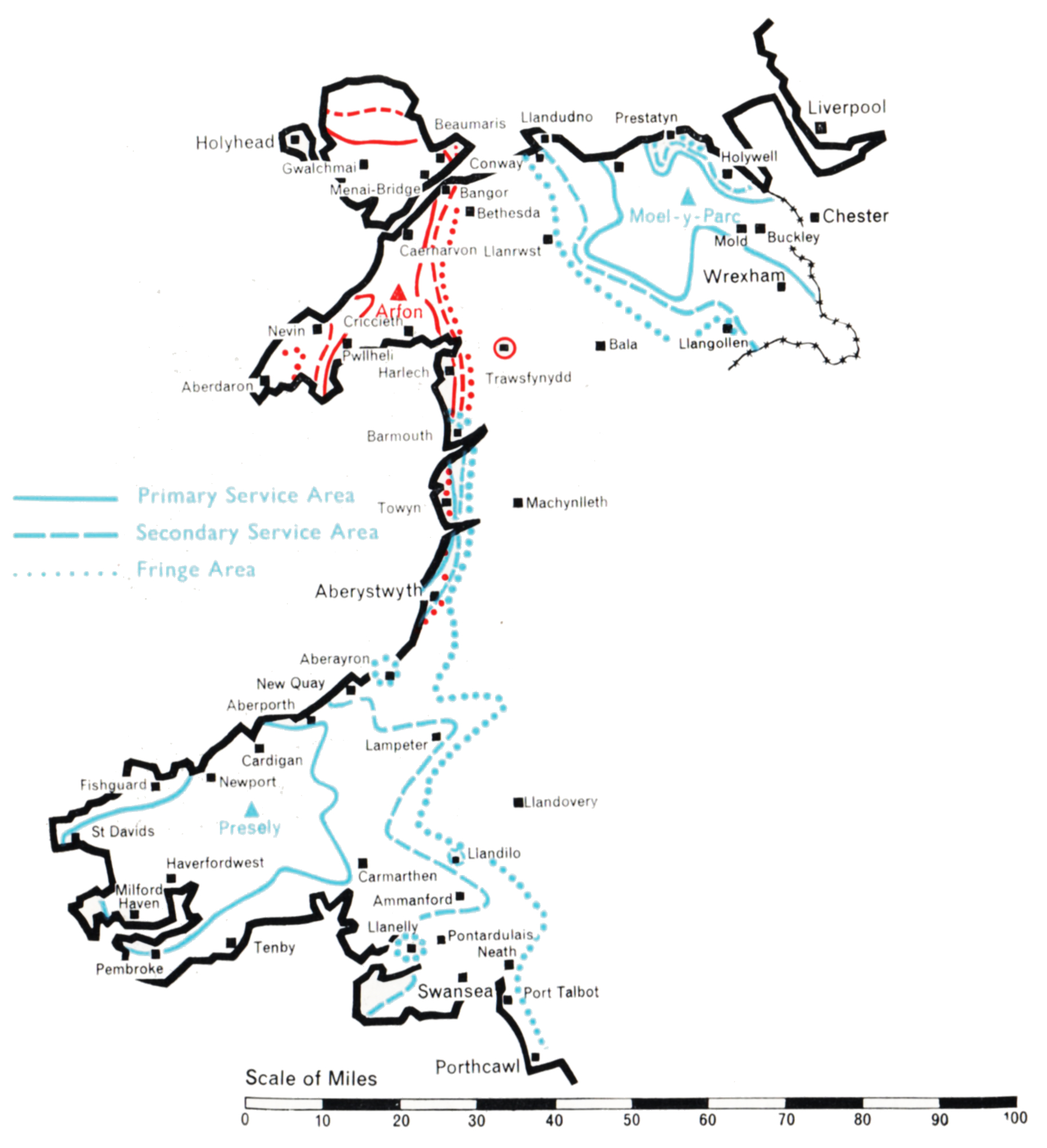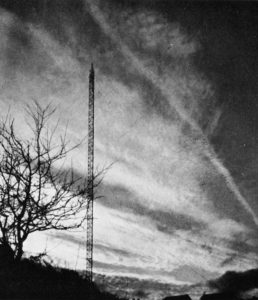West and North Wales

Wales (West and North) Television Limited is the company which, under agreement with the Independent Television Authority, provides the television programmes in West and North Wales during the whole week.
Wales Television Centre, Western Avenue, Cardiff.
CARDIFF 72364
33 Cathedral Road, Cardiff.
CARDIFF 37557
1 Great Cumberland Place, London W.1.
AMBassador 7700
ITA Channel Vision Sound Opening Date Population ITA Homes
Transmitter Frequency Frequency 000's 000's
Mc/s Mc/s
Presely 8 189.75675 186.27 14th Sept 1962 } } 74
Arfon 10 199.74725 196.2605 9th Nov. 1962 } 1,043 }
Moel-y-Parc 11 204.75675 201.27 28th Jan. 1963 } --
Directors
B Hayden Williams, PHD (Chairman); Colonel Cennydd G Traherne, TD, MA, KStJ, JP (Vice Chairman); The Hon Islwyn Davies, JP; S Kenneth Davies, CBE; TI Ellis, MA; Gwynfor Evans, MA, LL.B; Lady Olwen E Carey Evans; Moses Griffith, MSc; Alderman Llewelyn Heycock, CBE, JP; Tom Jones, OBE, JP; Sir David Hughes Parry, QC, MA, LL.D, DCL; Thomas Parry, MA, DLitt, FBA; Emrys Roberts, MBE, MA, LL.B; Eric L Thomas, LL.B, JP; William Thomas, CB, MA, DSc, PhD; David Tudor, MBE, JP; Peter O Williams, CBE, FCA; Sir Thomas Parry-Williams, MA, DLitt, PhD, Hon LL.D; Colonel John Williams-Wynne, DSO, MA, JP.
Officers
Nathan Hughes (General Manager); Ernest Byrne (Executive Producer); Havard Gregory (Senior Producer); Mansel Pugh (Secretary); Daniel Rees (Chief Engineer); Harry Sivell (Public Relations); Philip Thomas (Sales Director); JR Williams (Head of News); Macdonald Martin (Head of Film); Michael Glynn (Production Executive); John Treharne (Head of Presentation).
Staff
Total members of staff 138.
Visits to Studios
Applications should be made in writing to the Public Relations Manager.
Enquiries
Enquiries about artistes and programmes should be addressed to the Public Relations Department.
Submission of Scripts
Programme subject matter and scripts in the Welsh language should be submitted to the Senior Producer; all other scripts to the Executive Producer.
Programme Journal
Two programme journals are published weekly, one in the English language (Wales TV) and one in the Welsh language (Teledu Cymru), by a subsidiary company, Wales (West and North) Publications Limited.
Studios
The main studio (Studio A) is 2,400 sq. ft. and there is provision for an identical studio (Studio B) to be built alongside. Studios A and B can be used separately or as one large studio. The total floor area of the first phase which has been built is 22,000 sq. ft. and adjoining Studios A and B is a property store and technical store of 4,800 sq. ft. The control rooms are located above the property store and overlook the studios. The Studios are equipped with image orthicon cameras, telecine machines, Ampex V.T.R. machines and a caption scanner. The master control switching equipment was specially designed for Wales (West and North) Television Limited.
Programmes
Welsh and English language news bulletins; weekly English language sports programme, Welsh Sportlight; weekly Welsh language sports programme, Cip a’r Chwarae; a discussion programme, Impact, featuring controversial aspects of Welsh life and Welsh current affairs; Meet the Editor introduces the editors of local Welsh newspapers; Meet the Politician gives an insight into the lives and beliefs of prominent Welsh politicians; Heno I’r Plant, a Welsh language programme for children, featuring Welsh-speaking cartoon characters and an inter-school quiz; two weekly Welsh language magazine programmes, Golwg ar Gymru – one introduces interesting people and celebrates various anniversaries on alternate weeks and each week gives handy hints; the other explores various areas in Wales and subjects of particular Welsh interest. The Company has also produced a number of feature programmes on the Welsh Guards, Meet the Guards, Christmas Greetings from the Guards in Germany; and special programmes on Swansea and on Santa Claus. Each night Moment for Melody features well-known singers and gives amateur singers their opportunity. Popular network programmes are shown and certain schools programmes. In 1963 the Company is transmitting a monthly religious programme and introduces a new English programme on current Welsh affairs.
Local news
Wales (West and North) Television newsroom covers the whole of Wales and deals with all news items that have a specific impact on Wales as a nation. News and films and interviews are presented daily in both languages – Welsh and English. All members of the news staff are bilingual and copy is taken on the copy lines in whatever language the correspondent cares to send the news. The weather is also presented in Welsh and English.



